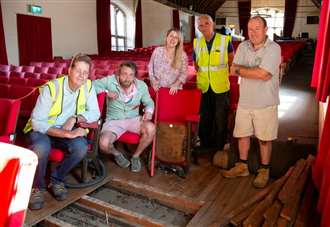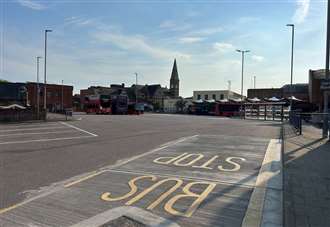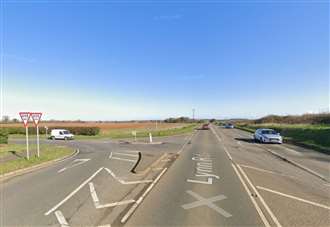
The only working theatre that can claim Shakespeare performed there is celebrating the “truly special” discovery of the actual boards on which he is believed to have trod.
The nearly 600-year-old oak floorboards have been uncovered at St George’s Guildhall in Lynn, England’s largest medieval guildhall, in what has been described as an “extraordinarily rare” find.
It has been hailed by archaeological building expert Dr Jonathan Clark as “the largest expanse of timber medieval flooring in the country”.
St George’s started out life as a religious Guild meeting house, confirmed by the Royal Charter in 1406, but it went on to become a theatrical venue – with the first recorded performance in 1445.
The Grade I listed building is the only working theatre in the world that can claim William Shakespeare himself performed there.
Archaeological work has been under way at the site for the last two months, which revealed the original floor hidden “in plain sight” beneath a 1960s and 1950s floors – as well as flooring believed to be from the 18th and 19th centuries.
Some of these floor beams have been tested and dated to between 1417 and 1430. The large oak boards are almost twelve inches thick, held together with pegs rather than nails.
It is believed the floor would have been laid by shipwrights and taken about a year to create.
Dr Paul Edmondson, head of research for The Shakespeare Birthplace Trust, said: “To see the medieval stage where Shakespeare might have performed rediscovered after centuries is an exciting opportunity.
“It’s a unique survival of theatre performances from a great period of English drama. This is a truly special discovery.”
Dr Clark said: “As archaeological finds go this is extraordinarily rare, especially on this scale.
“This is the largest timber 15th-century floor in the country, and that’s before you add the Shakespeare connection.
“Scientific analysis and the study of the structure confirms that it is a complete 15th-century floor so this floor would have been in situ when Shakespeare performed here in 1592-3. It’s a really fortuitous survival.
“The main reason it’s still there is because it’s totally integral to the building, it would have been really difficult to dismantle it without destroying the structure so they either had to patch it up or put another floor on top of it, which is why it’s still intact.”
Professor Sir Stanley Wells, honorary president of The Shakespeare Birthplace Trust, said: “Everyone interested in Shakespeare and in the theatres of his time must feel a thrill of excitement at the discovery of the only surviving boards on which he is likely to have performed.”
The project team at the Guildhall is now working out a plan to incorporate this exciting discovery into the major refurbishment currently being completed at the site.
Cllr Simon Ring, West Norfolk Council’s cabinet member for tourism, events, and marketing, said: “It is fantastic news indeed that such an eminent archaeologist as Dr Jonathan Clark is so confident that these beams at St George’s Guildhall are the original flooring from the early 1400s.
“It confirms the Guildhall as a heritage asset of national importance.
“It provides a further opportunity for us to promote its importance historically and to invite more funding so that we can complete the restoration to a standard that will not only stand the test of time but also create an attraction that will catapult Lynn and West Norfolk’s heritage into the world of ‘must visit’ British destinations.”
Vicky Etheridge, a Lynn Town Deal board member and project champion for St George’s Guildhall, said the floorboards have been “in plain sight for many years”, viewed from underneath as the corridor ceiling running underneath the theatre to the galleries behind.
She said: “To have confirmation that they are indeed the original floorboards of the stage, which have been covered for many years, is beyond exciting, and something that would not have come to light if we hadn’t developed this project and sought Town Deal funding from the UK Government under its Levelling Up agenda.
“Clearly, as a board, we will now be working with the project officers and experts to see how we can develop our plans to incorporate this discovery into the project and will be discussing any potential changes with the Government and other funders to ensure we maximise the opportunities this finding presents.”
Tim FitzHigham, creative director at West Norfolk Council, added: “I first heard the tale that Shakespeare had performed at the Guildhall as a kid but when I went back as an adult it seemed people had forgotten about it.
“Before I became creative director at the council, I had been involved in researching the history of the venue. We were able to demonstrate the connection of the town with Robert Armin and Shakespeare.
“Thanks to funding from the UK Government’s Towns Fund, under its Levelling Up agenda, a project to refurbish and redevelop St George’s Guildhall and associated buildings has been commenced by West Norfolk Council, in partnership with Norfolk Museums Service, Norfolk County Council and in collaboration with the National Trust who own the building.
“Thanks to this funding, we can get in experts like Dr Jonathan to enable us to be confident as to what these boards really mean, it makes this building important nationally and internationally.
“Shakespeare is known across the globe, so to be able to make this claim is pretty magical.”
The Lynn theatre was used extensively in the 1400s for touring companies – Queen Elizabeth’s Men, a troupe of actors formed at the command of the Tudor Queen in 1583, performed there ten times in the late 1500s.
Between 1592-93, London’s theatres were closed because of another outbreak of plague while William Shakespeare and his company of actors were on tour in Lynn.
A note in the corporation of Lynn’s account book shows Shakespeare’s company was paid by the corporation to perform there. This is not the only link to the famous playwright.
Robert Armin, who was Shakespeare’s leading comic actor and played comedy parts such as the Porter in Macbeth, the Gravedigger in Hamlet, Feste in Twelfth Night, and the Fool in King Lear, was born in the town, one street away from the theatre.
There is also evidence, in a book published during Shakespeare’s lifetime, of an incident that occurred at the Lynn theatre where an audience member watching a play about a murder on stage was so consumed with guilt she confessed to killing her own husband.
It is said that this incident inspired Shakespeare to write part of the plot of Hamlet with the Murder of Gonzago/Mousetrap scene.
Got a story? Email newsdesk@lynnnews.co.uk














